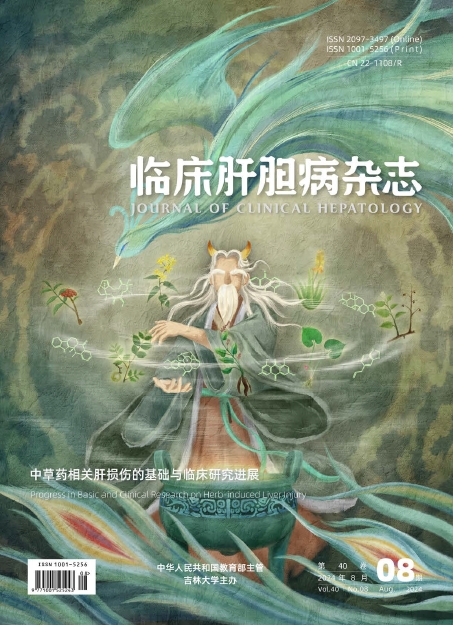| [1] |
DEVARBHAVI H, AITHAL G, TREEPRASERTSUK S, et al. Drug-induced liver injury: Asia Pacific Association of Study of Liver consensus guidelines[J]. Hepatol Int, 2021, 15( 2): 258- 282. DOI: 10.1007/s12072-021-10144-3. |
| [2] |
Branch of Hepatobiliary Diseases, China Association of Chinese Medicine, Branch of Chinese Patent Medicine, China Association of Chinese Medicine. Guideline for diagnosis and treatment of herb-induced liver injury[J]. J Clin Hepatol, 2016, 32( 5): 835- 843. DOI: 10.3969/j.issn.1001-5256.2016.05.003. |
| [3] |
MAO Y, MA S, LIU C, et al. Chinese guideline for the diagnosis and treatment of drug-induced liver injury: an update[J]. Hepatol Int, 2024, 18( 2): 384- 419. DOI: 10.1007/s12072-023-10633-7. |
| [4] |
Committee on DILI Prevention and Management, Chinese Medical Biotechnology Association; Study Group of Drug-Induced Liver Disease, Chinese Medical Association for the Study of Liver Diseases. Chinese guideline for diagnosis and management of drug-induced liver injury(2023 version)[J].[J]. Chin J Gastroenterol, 2023, 28( 7): 397- 431. DOI: 10.3760/cma.j.cn501113-20230419-00176. |
| [5] |
NUNES DRDCMA, MONTEIRO CSJ, DOS SANTOS JL. Herb-induced liver injury-a challenging diagnosis[J]. Healthcare(Basel), 2022, 10( 2): 278. DOI: 10.3390/healthcare10020278. |
| [6] |
LARREY D, VIAL T, PAUWELS A, et al. Hepatitis after germander(Teucrium chamaedrys) administration: Another instance of herbal medicine hepatotoxicity[J]. Ann Intern Med, 1992, 117( 2): 129- 132. DOI: 10.7326/0003-4819-117-2-129. |
| [7] |
LIN G, WANG JY, LI N, et al. Hepatic sinusoidal obstruction syndrome associated with consumption of Gynura segetum[J]. J Hepatol, 2011, 54( 4): 666- 673. DOI: 10.1016/j.jhep.2010.07.031. |
| [8] |
GARCÍA-CORTÉS M, STEPHENS C, LUCENA MI, et al. Causality assessment methods in drug induced liver injury: Strengths and weaknesses[J]. J Hepatol, 2011, 55( 3): 683- 691. DOI: 10.1016/j.jhep.2011.02.007. |
| [9] |
TESCHKE R, DANAN G. Worldwide use of RUCAM for causality assessment in 81, 856 idiosyncratic DILI and 14, 029 HILI cases published 1993-mid 2020: A comprehensive analysis[J]. Medicines(Basel), 2020, 7( 10): 62. DOI: 10.3390/medicines7100062. |
| [10] |
TESCHKE R, ZHU Y, JING J. Herb-induced liver injury in Asia and current role of RUCAM for causality assessment in 11, 160 published cases[J]. J Clin Transl Hepatol, 2020, 8( 2): 200- 214. DOI: 10.14218/jcth.2020.00009. |
| [11] |
KOTHADIA JP, KAMINSKI M, SAMANT H, et al. Hepatotoxicity associated with use of the weight loss supplement Garcinia cambogia: A case report and review of the literature[J]. Case Reports Hepatol, 2018, 2018: 6483605. DOI: 10.1155/2018/6483605. |
| [12] |
SMITH RJ, BERTILONE C, ROBERTSON AG. Fulminant liver failure and transplantation after use of dietary supplements[J]. Med J Aust, 2016, 204( 1): 30- 32. DOI: 10.5694/mja15.00816. |
| [13] |
LAUBE R, LIU K. An unwanted complement: Rare case of potential liver injury induced by an interaction between ginseng and atorvastatin[J]. Br J Clin Pharmacol, 2019, 85( 7): 1612- 1613. DOI: 10.1111/bcp.13927. |
| [14] |
HAYASHI PH, LUCENA MI, FONTANA RJ, et al. A revised electronic version of RUCAM for the diagnosis of DILI[J]. Hepatology, 2022, 76( 1): 18- 31. DOI: 10.1002/hep.32327. |
| [15] |
ZHAO XY, WANG Y, LAI RT, et al. Validation of the revised electronic version of RUCAM for diagnosis of DILI in Chinese patients[J]. Hepatol Commun, 2024, 8( 4): e0235. DOI: 10.1097/HC9.0000000000000235. |
| [16] |
ROCKEY DC, SEEFF LB, ROCHON J, et al. Causality assessment in drug-induced liver injury using a structured expert opinion process: Comparison to the Roussel-Uclaf causality assessment method[J]. Hepatology, 2010, 51( 6): 2117- 2126. DOI: 10.1002/hep.23577. |
| [17] |
State Drug Administration. Technical guidelines for clinical evaluation of liver injury induced by traditional Chinese medicine[J]. J Clin Hepatol, 2018, 34( 7): 1403- 1409. DOI: 10.3969/j.issn.1001-5256.2018.07.008. |
| [18] |
HE TT, LIANG QS, WANG LP, et al. Diagnostic values of integrated evidence chain, Roussel Uclaf Causality Assessment Method, and Structured Expert Opinion Process method for drug-induced liver injury[J]. J Clin Hepatol, 2022, 38( 1): 141- 147. DOI: 10.3969/j.issn.1001-5256.2022.01.022. |
| [19] |
CHAU TN, CHEUNG WI, NGAN T, et al. Causality assessment of herb-induced liver injury using multidisciplinary approach and Roussel Uclaf Causality Assessment Method(RUCAM)[J]. Clin Toxicol(Phila), 2011, 49( 1): 34- 39. DOI: 10.3109/15563650.2010.537662. |
| [20] |
HOOFNAGLE JH, BONKOVSKY HL, PHILLIPS EJ, et al. HLA-B*35:01 and green tea-induced liver injury[J]. Hepatology, 2021, 73( 6): 2484- 2493. DOI: 10.1002/hep.31538. |
| [21] |
LI CP, RAO T, CHEN XP, et al. HLA-B*35:01 allele is a potential biomarker for predicting Polygonum multiflorum-induced liver injury in humans[J]. Hepatology, 2019, 70( 1): 346- 357. DOI: 10.1002/hep.30660. |
| [22] |
SARGES P, STEINBERG JM, LEWIS JH. Drug-induced liver injury: Highlights from a review of the 2015 literature[J]. Drug Saf, 2016, 39( 9): 801- 821.
|
| [23] |
LEWIS PJ, DEAR J, PLATT V, SIMPSON KJ, et al. Circulating microRNAs as potential markers of human drug-induced liver injury[J]. Hepatology, 2011, 54( 5): 1767- 1776.
|
| [24] |
JIE Z, et al. Integrated expression profiles of mRNA and microRNA in the liver of Fructus Meliae Toosendan water extract injured mice[J]. Frontiers in Pharmacology, 2015, 6: 236. DOI: 10.3389/fphar.2015.00236. |







 DownLoad:
DownLoad: